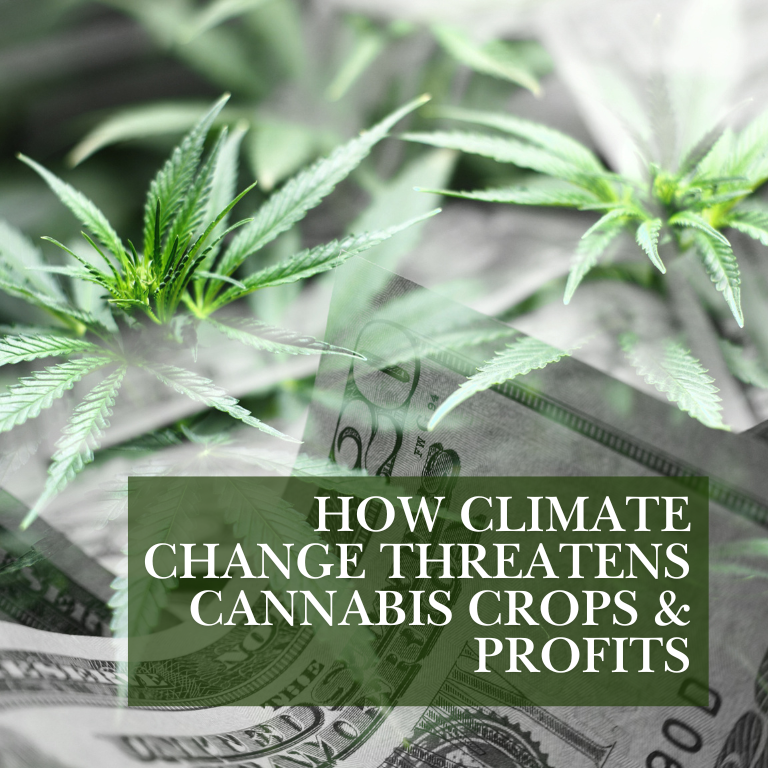As Global Temperatures Rise, Temperamental Weather Systems Are Damaging Crops with Wildfire Smoke and Drought, Leading Cannabis Cultivators to Face Several Complex Challenges
Climate change is no longer a distant concern—it is an immediate crisis that is already reshaping industries worldwide, including cannabis cultivation. As global temperatures rise, unpredictable weather patterns, intense droughts, and frequent wildfires are placing immense pressure on cannabis growers. The effects are not only visible in lower yields but also in a decline in product quality, economic losses, and regulatory complications.
For cannabis cultivators, the combination of smoke exposure, water scarcity, and regulatory barriers creates a uniquely challenging landscape. While some growers are discovering ways to adapt, many are struggling to keep their businesses afloat. This article explores the many threats cannabis cultivators face due to climate change and examines how they are attempting to mitigate these impacts.
The Devastating Consequences of Wildfire Smoke on Cannabis Crops and the Hidden Damage It Causes
Wildfires have become a seasonal nightmare for cannabis farmers, especially in states like California and Oregon. The 2020 Slater Fire serves as a prime example of the devastating impact of these fires, not just because of the flames themselves, but because of the smoke that lingers for weeks, sometimes even months.
Mason Walker, CEO of Oregon-based East Fork Cultivars, experienced this firsthand when his cannabis farm was engulfed in wildfire smoke for over two weeks. The effects were immediate: workers struggled to breathe, plants were exposed to harmful particulates, and the air quality was so poor that the farm had to take emergency measures, such as distributing respirators and sealing indoor spaces with high-efficiency particulate air (HEPA) filters.
While East Fork’s crops did not burn, the wildfire smoke led to a significant decrease in yield and quality. Some customers reported that the cannabis they purchased smelled like a barbecue pit, leading to returns and financial losses. Despite these setbacks, Walker’s company was able to recover due to an unexpected pandemic-driven sales surge. However, the long-term implications of recurring wildfires remain a serious threat.
Wildfire Smoke Damage on Cannabis: How Airborne Particles and Toxins Alter the Chemistry of the Plant
The real danger of wildfire smoke to cannabis crops isn’t just the physical coverage of ash—it’s the microscopic changes in plant chemistry that make the product less desirable or even unsafe. Smoke exposure introduces volatile organic compounds (VOCs) and polycyclic aromatic hydrocarbons (PAHs) into the environment, which can be absorbed by the plant’s trichomes.
Cannabis plants are particularly vulnerable during the flowering stage when their resin glands are highly absorbent. The inhalation of these toxins by consumers raises health concerns, prompting some growers to conduct additional testing to ensure their products remain safe. A study by UC Berkeley found that wildfire smoke can lead to cannabinoid degradation and terpene loss, making the final product less aromatic and less potent.
To combat this issue, some cultivators are investing in filtration systems, greenhouses, and controlled-environment agriculture (CEA) techniques. However, these solutions require significant capital investment, making them inaccessible to many smaller farms.
The Economic Toll of Climate Change on Cannabis Farmers: Revenue Losses, Supply Chain Disruptions, and Insurance Challenges
The financial burden of climate change on cannabis cultivators is immense. A 2023 study from UC Berkeley revealed that the economic impact of wildfire smoke alone on California’s cannabis industry in 2021 was estimated at $1.44 billion. Beyond direct losses in yield, growers face supply chain disruptions, increased costs for protective measures, and higher insurance premiums.
Insurance options for cannabis cultivators remain limited, with many policies excluding damages from wildfire smoke or extreme weather events. Unlike traditional agriculture, cannabis does not benefit from federal crop insurance programs, leaving growers financially vulnerable to natural disasters.
Companies like Indus, now part of Lowell Farms, have publicly disclosed how wildfires have hurt their bottom line. In 2020, the company warned investors that plant stress due to smoke exposure could result in revenue losses of up to $4.5 million. For smaller farms, such losses could mean permanent closure.
How Water Scarcity and Drought Conditions Are Threatening Cannabis Farms Across the United States
Drought is another major challenge affecting cannabis cultivation. As water sources become more scarce, growers must find innovative ways to keep their plants hydrated while remaining compliant with state regulations.
A 2024 study found that intense drought conditions not only reduced cannabis yield but also led to a decline in cannabinoid production. Since cannabis is a water-intensive crop, restrictions on water usage can directly impact potency levels and overall plant health.
In California, where water rights are highly regulated, some cultivators face legal and logistical challenges when sourcing water. Meanwhile, illegal grow operations continue to divert water, exacerbating shortages for licensed businesses. Without access to alternative water sources or state assistance, legal cannabis farms are at a significant disadvantage.
Heavy Rain and Flooding: An Overlooked Threat to Cannabis Crops That Can Reduce Cannabinoid Potency
While droughts pose a clear risk to cannabis farms, excessive rainfall and flooding can be just as damaging. Heavy rain can wash away nutrients from the soil, drown plant roots, and increase the risk of mold and mildew growth.
Additionally, flooding can lead to high levels of nitrates in groundwater, which cannabis plants absorb through irrigation. Studies show that increased nitrate levels can lower THC and CBD potency, reducing the overall market value of the crop.
Growers facing persistent rain events must invest in drainage systems and soil management techniques to prevent waterlogging. However, like most climate adaptation strategies, these solutions come with added costs.
The Regulatory Roadblocks Preventing Cannabis Farmers from Receiving Federal Aid During Natural Disasters
One of the biggest challenges cannabis farmers face is the lack of federal support during climate-related disasters. While traditional farmers can apply for assistance from the Farm Service Agency (FSA) or the Noninsured Crop Disaster Assistance Program (NAP), cannabis remains federally illegal, disqualifying growers from these resources.
Mason Walker of East Fork Cultivars describes the cannabis industry as operating on “razor-thin profit margins,” making disaster recovery even more difficult without federal aid. This disparity has fueled ongoing discussions about policy changes that could allow cannabis businesses to access the same emergency funding available to other agricultural sectors.
Innovative Strategies Cannabis Growers Are Using to Mitigate Climate Change Risks and Improve Crop Resilience
Despite these challenges, some cannabis cultivators are finding ways to adapt to the changing climate. Advances in genetics and breeding have helped develop more resilient cannabis strains that can withstand drought, heat stress, and smoke exposure.
Walker and his team at East Fork partnered with a testing lab to analyze which cannabis varietals were most affected by wildfire smoke. They discovered that plants with higher sugar content suffered more damage, while those with high terpene levels were more vulnerable to smoke absorption. Armed with this knowledge, they are now selecting strains that are better suited for extreme conditions.
Other adaptation strategies include:
Transitioning to indoor or greenhouse cultivation to reduce exposure to external threats.
Investing in water conservation techniques such as drip irrigation and rainwater collection.
Using soil amendments to improve plant resilience against stressors.
While these solutions may help, they come with financial barriers that not all farmers can overcome.
The Future of Cannabis Cultivation in a Climate-Impacted World
As climate change continues to disrupt global agriculture, cannabis cultivators must navigate a future filled with uncertainty. Wildfires, droughts, and extreme weather events will likely become more frequent, placing even more pressure on farmers to adapt or risk losing their livelihoods.
Without federal assistance or industry-wide climate adaptation initiatives, many growers face an uphill battle. However, those who invest in innovative growing techniques, research new genetics, and push for policy changes may find a path to long-term sustainability in this rapidly evolving industry.
OG source














